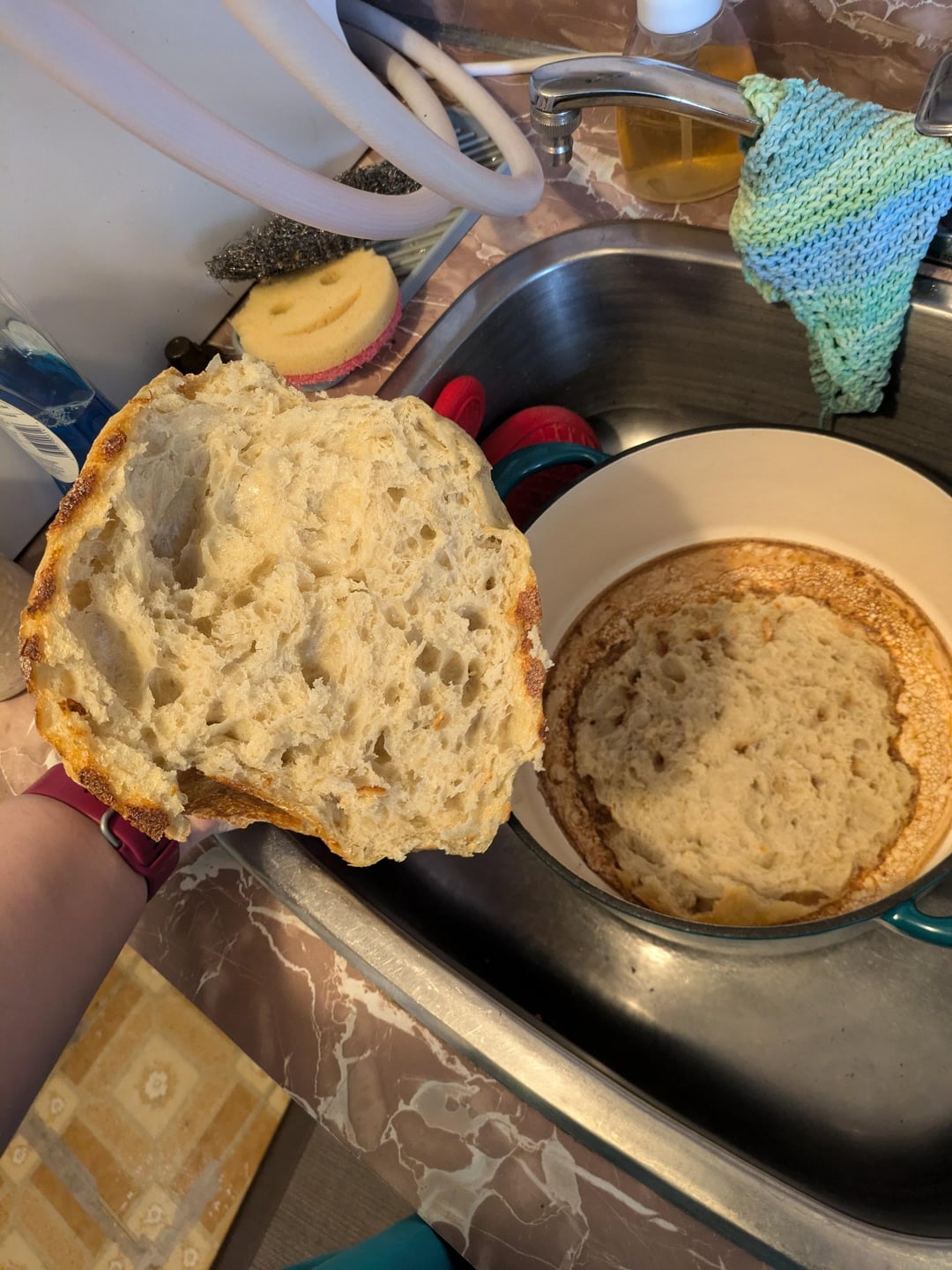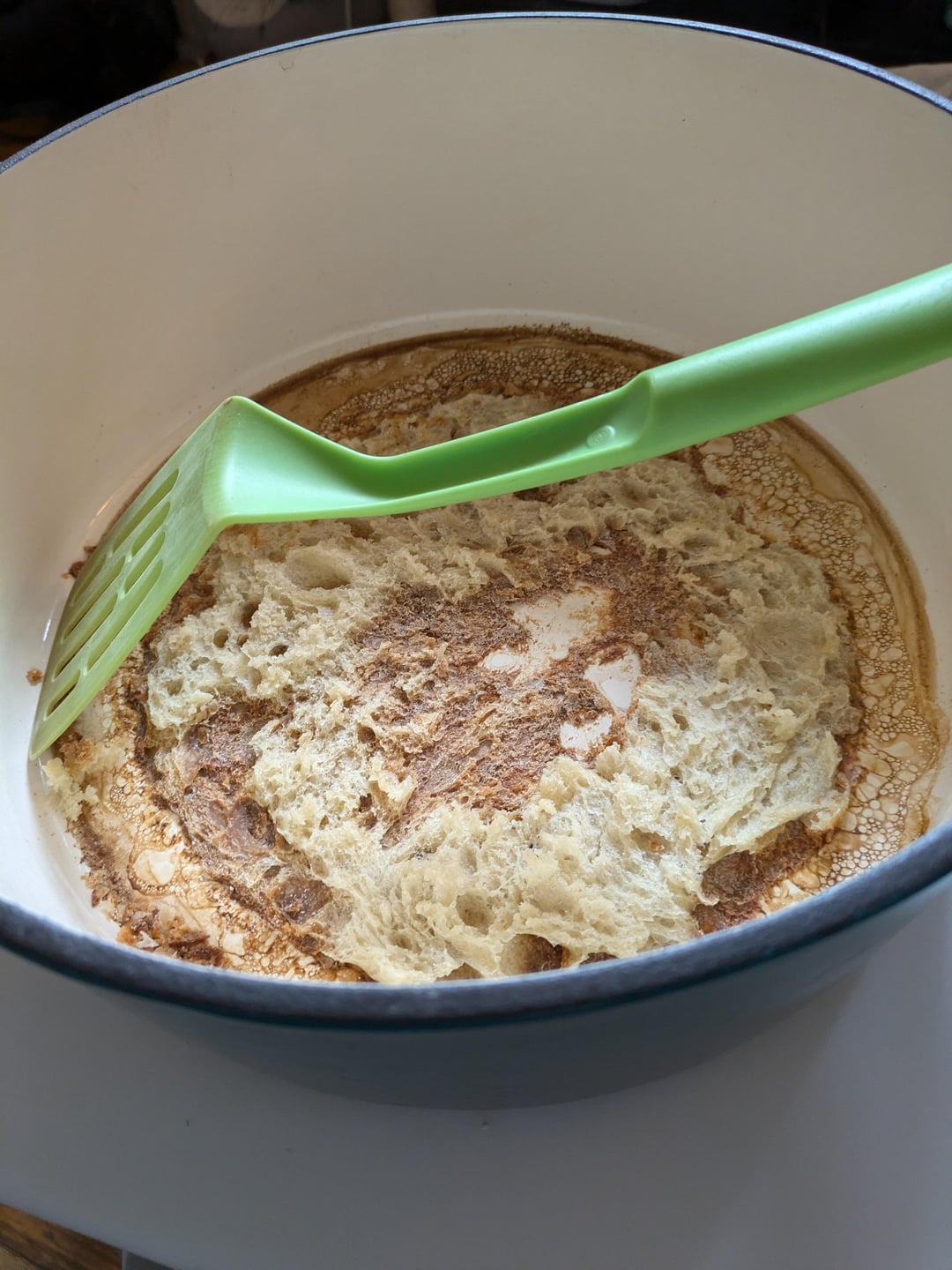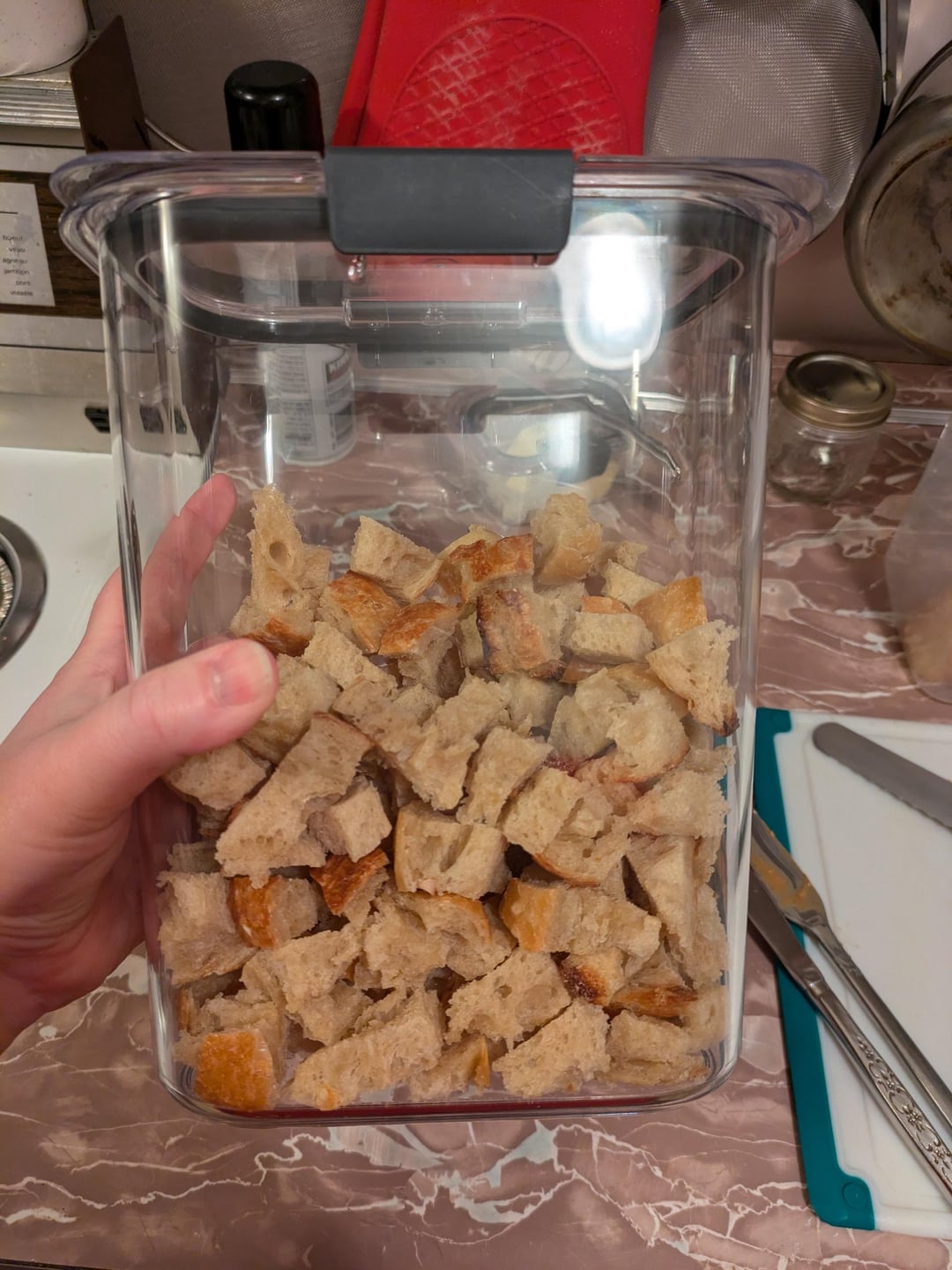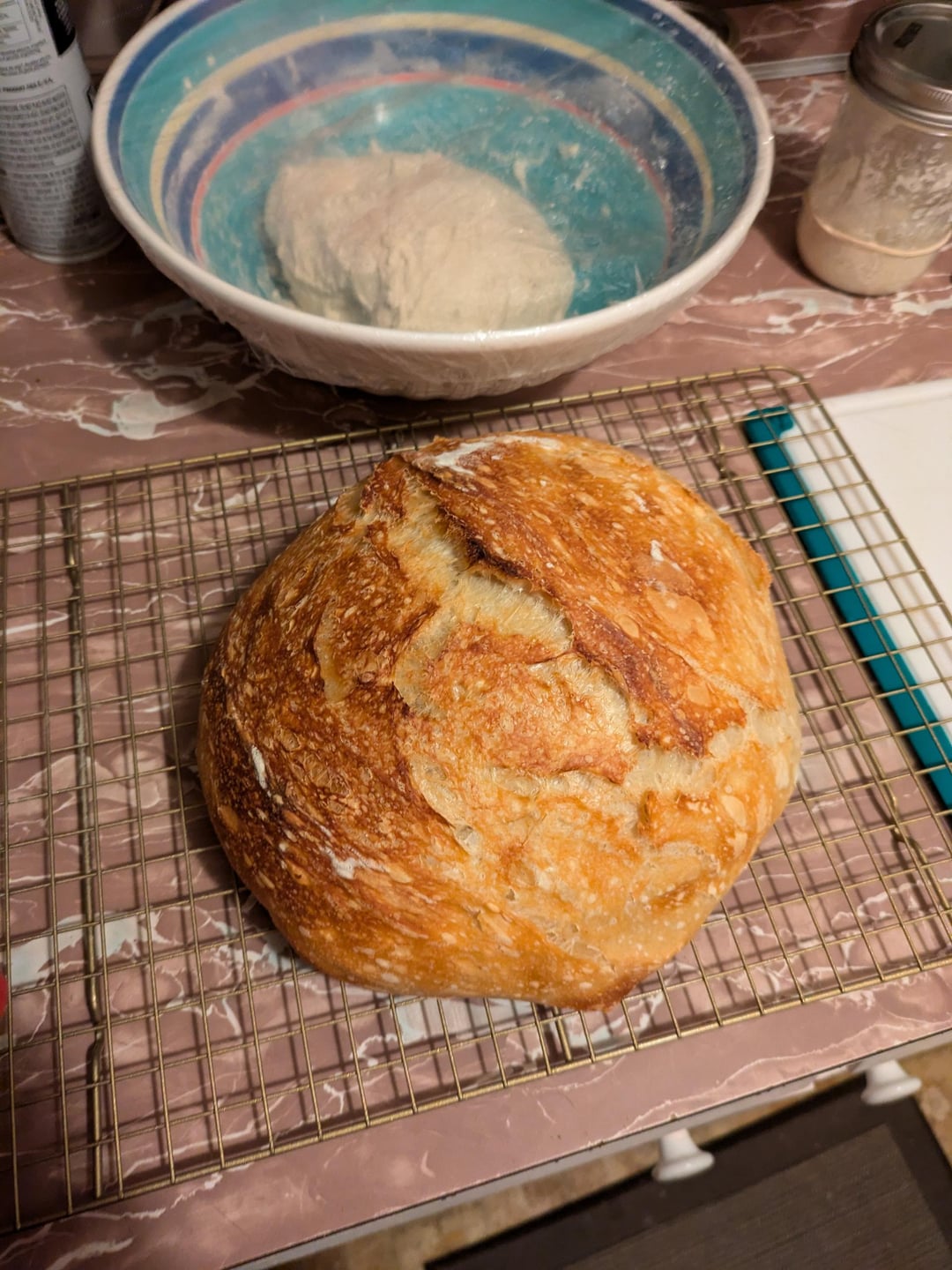



Not really looking for feedback, just look at this horrendous screw up I did 😂 any one else have some horrendous screw up stories they would like to share?
I am chronically ill, and when I over do it my brain doesnt work too well. This was a few days ago and I made the silly mistake of making three things simultaneously, totally wearing myself out. (Regular yeast bagels, hamburger buns, and sourdough bread)
For some reason I thought, do I actually need parchment paper? Let's try without. The fatal mistake, i think, is i had been experimenting with adding an ice cube to get extra steam in the dutch oven, and that lead to this awful mess where it fully glued itself to the bottom. Impossible to get off. I turned it into breadcrumbs, though, which i was planning on making soon anyway as Canadian Thanksgiving is in about a week.
I've only been baking sourdough a couple months – i added my most recent loaf as the last picture.
Recipe:
50-100g starter (more or less depending on timeframe desired)
2 tsp salt
350 g water
500 g flour
Have only been doing one fold as per original recipe is an "overnight" recipe, but just started to do more when I am doing it during the day. Bulk ferment for 10+ hours. Shape and proof for 45+ minutes. Bake in cold dutch oven for 30 minutes at 450°F then remove the lid and bake for another 20 minutes
by rudyruday

14 Comments
Next time, put the lid on and turn the Dutch oven upside down. The trapped steam will help release it from the bottom within a couple minutes.
RIP loaf. Literally in this case.
I never use parchment paper for what it’s worth, but I do have a mix of rice and bread flour on the bottom of the loaf as it bakes.
You cant put it in a cold Dutch oven. It will stick every time. In my opinion…
Never sticks for me but I put it in a hot dutch oven. I guess that’s the difference.
Could I ask how you made your breadcrumbs at least? Also relatively new to sourdough and I’ve been trying to experiment with smaller loaf sizes and when I don’t get the bake time right, I’d like to turn it into something else 😅
RIP your Dutch oven
Hi. Hard luck. We all have disasters time to time. You DO isn’t lost give it a long soak no detergent. At least 24 hours. Clean out softened dough and ant residue soak in white vinegat til it brushes away.
Hope the following ay be useful.
Phases:
• Mixing dough: The start of bulk fermentation.
This is basic method only put dry ingredients in bowl and combine. Add water and levain stir with stiff spoon or hand until all dry flour is combined. At this stage you have a chance to adjust your hydration to suit the flour but, over the next hour or two the flour will absorb more of the free fluids. So, aim for stickier than drier. I work the dough at this stage to a ensure that the dough is binding as a cohesive ‘ball’. Now the dough needs to rest.
Fermentation is a continuous process. Usually split in two. Bulk fermenttion is when multiple loaves are fermented together in one batch. Then proofing after the ‘ bulk ‘ has been reduced to individual loaves and shaped. Often times the proofing is done in refridgerated conditions to refine baking process. Especially with sourdough.
It is important to adjust the point at which the one finishes and the other starts. There needs tp be just enough ‘food’ to sustain the yeast through to baking. This is usually guaged by the % rise in volume of the raw dough. The longer the intended proofing the lower the % age rise. There are several other ways to guage the curtailment point tho.
My preferred rise is about 75%. I measure the volume of the just mixed dough and then finish the ferment in a bowl marked to double that.
You allready hsve a recipe the works for you this may give you some ideas
Recipe:
Terms.
• Bakers pecentage; the total weight of flour(levain and bulk flour) is 100%
• Starter; a cultivation of the natural wild yeasts and bacteria in flour and water
• Levain; the weight of active and vigorous stsrter to activate a the dough in your
The general proportions of a recipe
• Starter, 20 %
• Salt, 2%
• Water, depends on flour and desired outcome but a good starting point is 65%
My go to recipe.
Starter: 125 grams ( stong white bread flour 80: Whole wheat or Rye 20%; 600g of SWBF or a mixture of flours (necessitating different hydration) 13g salt and 400g water
And
FLOURS
• AP flours: generally lower in the protien scale and softer. As a result lower gluten formation, less shapability and loer hydration factor. However tebds to make fluffier texture
• strong white bread flour: high protien 12 to 15 % with high gluten formation also high hydration factors. High gluten formation leads to good shaping
• whole grain flours: whole wheat and Rye particularly. High hydration factor and adds additional nutrion factors and yeast strains. Tends envigorate levain but bran flakes are sharp and lacerate the forming gluten creating holes and loss of gas.
• ancient whole grain: add taste and nutrition but tend to have lower protein and therefore reduced gluten formstion and hydration.
Happy baking
I’ve actually had my loaves stick to parchment paper too…best was to prevent is rubbing a good amount of flour on the bottom of the loaf before setting it down in the Dutch oven
I lower the dough in using a wide strip of parchment paper. Does not matter if paper edges make it inside the Dutch oven. Also, I dust the dough ball in non-glutenious rice flour before placing it on the paper
Bread cubes were a great save!!
I use rice flour liberally. Sprinkle the DO and the loaf (since it looks like it will be touching the sides too). It never sticks.
This has been an interesting post for the comments to see how some people use parchment and some don’t.
I would advise not using a cold Dutch oven. Dutch ovens should be slowly warmed up. It’s not a good idea to put a non-heated one with your loaf into a hot oven.
I have always used parchment paper. I don’t recall ever having mine stick to parchment. I guess it would really depend on your bread hydration. I do line the bottom of my lodge combo cooker with dried oatmeal. Then I put my parchment ontop. The oatmeal acts as a protective layer to prevent the bottom getting too burnt and too chewy.
You can do it without parchment paper. You need to preheat the oven – and the Dutch oven – for an hour prior to putting bread in.
I have had that happen with sheet pan pizza. Making some today and it will be oiled parchment.